Historic San Ildefonso Pueblo Polychrome Jar with Red Rim - SC3680E
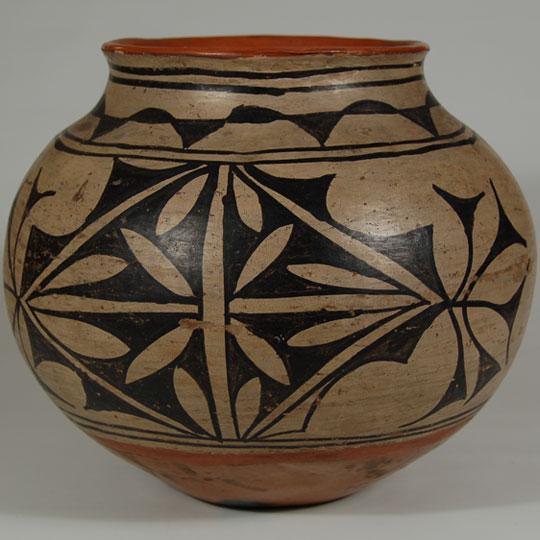 According to information published by the noted expert on historic Pueblo pottery, Frank Harlow, pottery production declined considerably at San Ildefonso Pueblo until, by 1830, its output was limited to large storage jars and a few smaller jars. Families at San Ildefonso traded food and other items to Nambe Pueblo potters in exchange for pottery needed for their use. This continued until around 1880, at which time pottery production at San Ildefonso underwent a revitalization sparked by the arrival of tourists on the newly instituted the Atchison, Topeka and Santa Fe Railway cross-country train. The new pottery being produced was designated as San Ildefonso Polychrome with a beginning date of 1880 and an end date that is yet to be determined.
According to information published by the noted expert on historic Pueblo pottery, Frank Harlow, pottery production declined considerably at San Ildefonso Pueblo until, by 1830, its output was limited to large storage jars and a few smaller jars. Families at San Ildefonso traded food and other items to Nambe Pueblo potters in exchange for pottery needed for their use. This continued until around 1880, at which time pottery production at San Ildefonso underwent a revitalization sparked by the arrival of tourists on the newly instituted the Atchison, Topeka and Santa Fe Railway cross-country train. The new pottery being produced was designated as San Ildefonso Polychrome with a beginning date of 1880 and an end date that is yet to be determined.
Diné - Navajo Sterling Silver and Turquoise Triangular Shaped Ring - C3077J
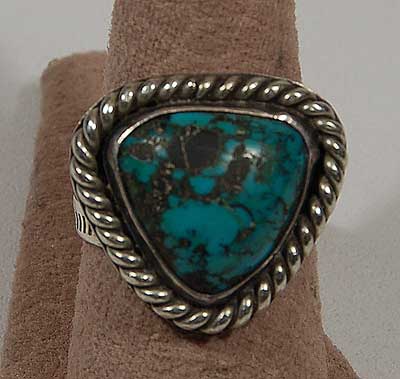 This ring consists of a beautiful turquoise stone with a chocolate brown matrix set in a triangular shaped twisted wire bezel. The split shank is hand stamped. The Southwest Indian Jewelry ring is unsigned and in very good condition.
This ring consists of a beautiful turquoise stone with a chocolate brown matrix set in a triangular shaped twisted wire bezel. The split shank is hand stamped. The Southwest Indian Jewelry ring is unsigned and in very good condition.
Sterling Silver Spoon from the Estate of Mary B. Carter - 23612
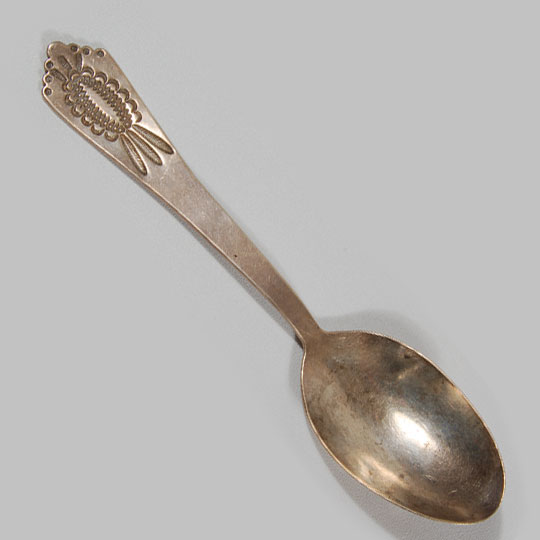 This sterling silver spoon has a stamp design on the handle that is typical of Navajo stamp work from the 1920-1930 period. It is not stamped with the name of a maker, which is not unusual for that period.
This sterling silver spoon has a stamp design on the handle that is typical of Navajo stamp work from the 1920-1930 period. It is not stamped with the name of a maker, which is not unusual for that period.
Original Painting “Autumn Sunset” by Carl Von Hassler - C3715
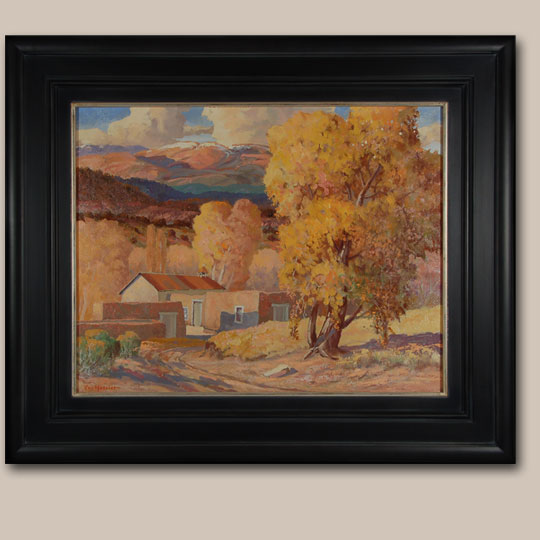 Carl Von Hassler specialized in painting scenes of Northern New Mexico villages, specifically selecting a single homestead in any of the four seasons. In this painting, he selected an adobe structure with a steeple nestled among cottonwood trees with their leaves turning yellow at the beginning of the fall season. The church or possibly school house has a pitched roof with painted tin as its cover. The other buildings are flat-roof adobe structures.
Carl Von Hassler specialized in painting scenes of Northern New Mexico villages, specifically selecting a single homestead in any of the four seasons. In this painting, he selected an adobe structure with a steeple nestled among cottonwood trees with their leaves turning yellow at the beginning of the fall season. The church or possibly school house has a pitched roof with painted tin as its cover. The other buildings are flat-roof adobe structures.
Diné - Navajo Silver and Turquoise Concha Belt by Billy Goodluck - 23987
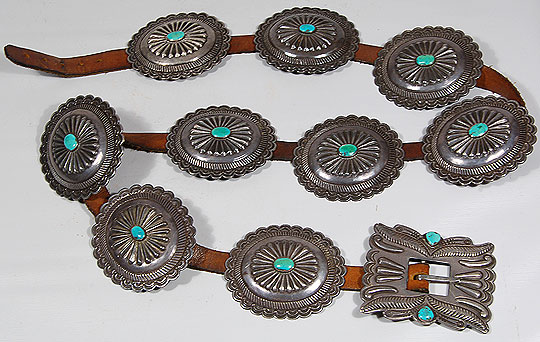 The Diné are a people who have added much beauty to their world and ours. Beauty is a quality they particularly appreciate; it is a repeated theme in their songs, ceremonies and in their rugs and jewelry.
The Diné are a people who have added much beauty to their world and ours. Beauty is a quality they particularly appreciate; it is a repeated theme in their songs, ceremonies and in their rugs and jewelry.
The Diné lifestyle and arts are those of a nomadic. They depend heavily on the horse and lavish their creative talents in weavings and silverwork on them. Perhaps there is some correlation in living with nature that sparks their creativity.
In the early twentieth century, banks were non-existent on the Navajo Reservation. As a result, the Navajo tended to invest their wealth into jewelry and if they needed money, they could pawn the jewelry at the local trading post. One popular form of jewelry that is distinctly Navajo is the concha belt.
San Ildefonso Pueblo Polychrome Lidded Jar by Martina Vigil and Florentino Montoya - C3675Z
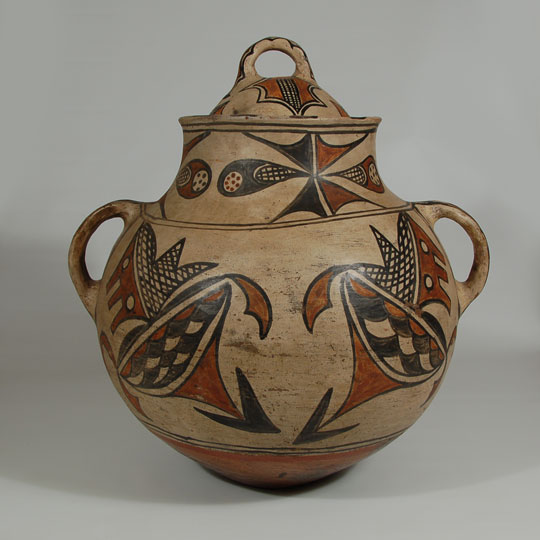 It is known that Maria and Julian Martinez, after their marriage in 1904, became known as the best pottery couple in the pueblo, but this might not have happened had another couple from San Ildefonso not moved to Cochiti Pueblo in 1905. That couple, Martina Vigil Montoya (1856-1916) and her husband Florentino Montoya (1858-1918), were the finest potters from there from as early as the 1880s. They were masters at creating magnificent Polychrome jars. Martina had learned pottery making from her mother, Toña Peña Vigil, who also was a very talented potter. Florentino had studied the designs of Toña's pottery and adapted his style on hers.
It is known that Maria and Julian Martinez, after their marriage in 1904, became known as the best pottery couple in the pueblo, but this might not have happened had another couple from San Ildefonso not moved to Cochiti Pueblo in 1905. That couple, Martina Vigil Montoya (1856-1916) and her husband Florentino Montoya (1858-1918), were the finest potters from there from as early as the 1880s. They were masters at creating magnificent Polychrome jars. Martina had learned pottery making from her mother, Toña Peña Vigil, who also was a very talented potter. Florentino had studied the designs of Toña's pottery and adapted his style on hers.
Acrylic on Canvas “Maize Maze” by Alice Warder Seely - C3689C
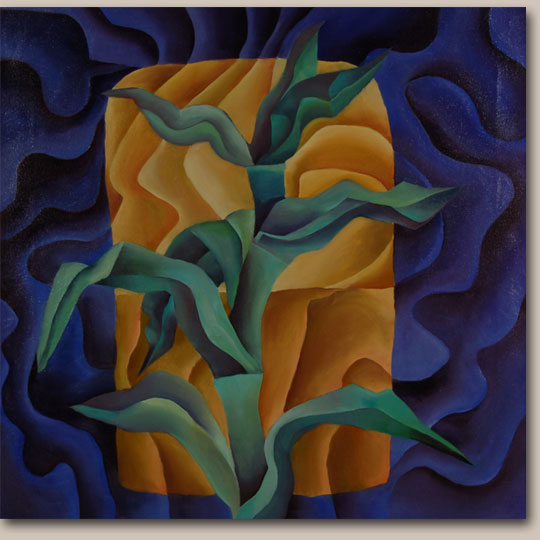 Alice Seely is an amazing woman and an amazing artist. She had a rewarding young life living in Santa Fe near Canyon Road and Garcia Street with her parents in a John Gaw Meem adobe home. The family was well off financially. Her family heritage is mixed Indian, Spanish and Anglo as were many Santa Fe residents of the time. Her paternal grandparents lived in a small Spanish village in Northern New Mexico and were descended from Pueblo and Comanche Indians. Her biological father was a New Mexico muralist and landscape painter. Her step father was Navajo artist Narciso Abeyta (Ha-So-De), father of artist Tony Abeyta. Alice is a painter, jeweler, and amateur horticulturist, raising hundreds of Iris on her farm in Ruidoso, New Mexico.
Alice Seely is an amazing woman and an amazing artist. She had a rewarding young life living in Santa Fe near Canyon Road and Garcia Street with her parents in a John Gaw Meem adobe home. The family was well off financially. Her family heritage is mixed Indian, Spanish and Anglo as were many Santa Fe residents of the time. Her paternal grandparents lived in a small Spanish village in Northern New Mexico and were descended from Pueblo and Comanche Indians. Her biological father was a New Mexico muralist and landscape painter. Her step father was Navajo artist Narciso Abeyta (Ha-So-De), father of artist Tony Abeyta. Alice is a painter, jeweler, and amateur horticulturist, raising hundreds of Iris on her farm in Ruidoso, New Mexico.
Seated Pueblo Pottery Koshare Clown Figurine by Nah-Glee-eh-Bah - 25801
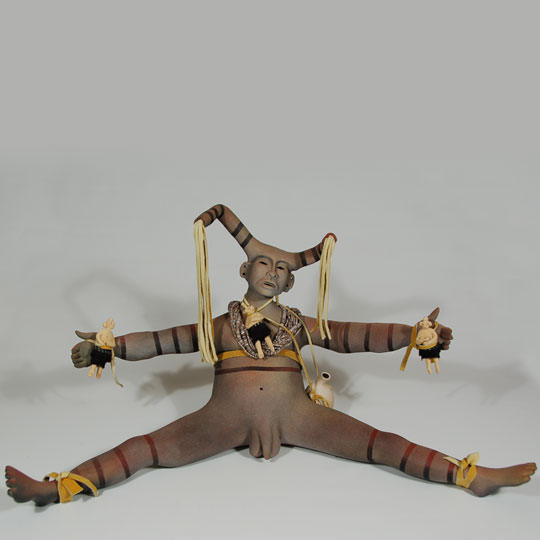 Rarely are we able to find pottery sculptures by Elizabeth Abeyta, Navajo artist and daughter of acclaimed painter Narciso Abeyta, and sister of Navajo artist Tony Abeyta. Her sculptures are rarely seen on the market since her untimely death in 2006.
Rarely are we able to find pottery sculptures by Elizabeth Abeyta, Navajo artist and daughter of acclaimed painter Narciso Abeyta, and sister of Navajo artist Tony Abeyta. Her sculptures are rarely seen on the market since her untimely death in 2006.
This elegant piece depicts a seated Pueblo Koshare clown leaning back slightly with legs spread out, eyes closed, and arms outspread. He holds a Mudhead Katsina doll in each hand, has one tied around his neck, wears a hieshe necklace and has leather straps on his ankles and wrists. Around his neck is a leather strap that holds a water canteen. On his head he wears the customary clown headdress, normally with horns of untanned sheepskin that are traditionally stuffed with heavy grass and tasseled at the tips with crinkled cornhusk strips. His arms and legs are painted in black stripes as would be on a real Koshare.
Female Figure Standing on Crescent Moon Painting by Tony Abeyta - 25803
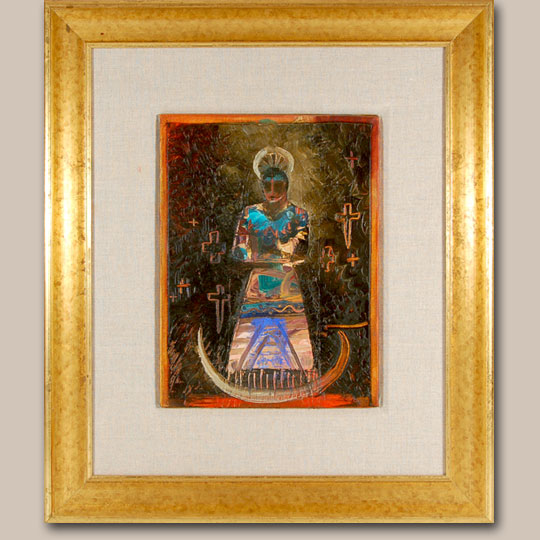 It is most interesting to see a painting of this subject matter by Tony Abeyta, as much of his earlier work was devoted to Navajo religious or ceremonial subjects, particularly involving the Yei and Yeibichai Navajo supernatural beings. This painting can be interpreted as representing the Virgin Mary - mother of Jesus.
It is most interesting to see a painting of this subject matter by Tony Abeyta, as much of his earlier work was devoted to Navajo religious or ceremonial subjects, particularly involving the Yei and Yeibichai Navajo supernatural beings. This painting can be interpreted as representing the Virgin Mary - mother of Jesus.
Many paintings of the various representation of Mary-Our Lady of Guadalupe, Nuestra Senora de la Conception, and others-have Mary standing on a crescent moon, a symbol of Islam, a symbol that has been carried historically on the flags of many Muslim armies throughout history. That the moon beneath her feet has at times taken the shape of the crescent serves as a reminder of her intercessions against Islam. She is connected to the Spanish Reconquista and their ultimate defeat of the centuries-long Islamic invasion of their homeland. 1P5-1Peter5 website
Original Cochiti Casein Painting “Indian Farmer” by Johnnie Quintana - C3716
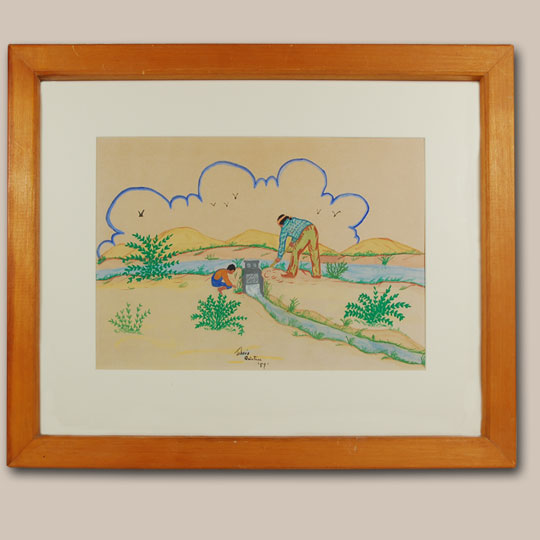 The Cochiti Pueblo painting illustrates a farmer having opened the sluice gate so water flows to his fields. A young boy kneels nearby, apparently playing rather than assisting. The painting is quite detailed with hills in the background, foliage in the foreground, water in the Acequia, birds flying overhead and outlines of clouds. Quite an accomplishment for a high school student.
The Cochiti Pueblo painting illustrates a farmer having opened the sluice gate so water flows to his fields. A young boy kneels nearby, apparently playing rather than assisting. The painting is quite detailed with hills in the background, foliage in the foreground, water in the Acequia, birds flying overhead and outlines of clouds. Quite an accomplishment for a high school student.
The painting is signed in lower center Johnnie Quintana and dated 1957. It has recently been framed with acid-free materials and placed back in the original frame which appears to be an Indian School handmade frame.
Santa Clara Pueblo Original Painting of a Green Fish by Helen Hardin - 25794
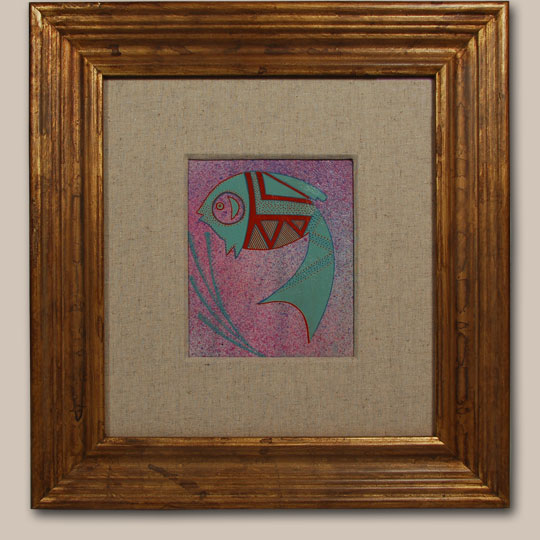 Helen Hardin, from the very beginning of her career, was at the cutting edge of Indian-influenced art. Her art, though obviously drawing on her Indian heritage and tradition, was very much in the mainstream of modern aesthetics. This fine acrylic painting on artist board does not reflect a date. It is a simple drawing of a fish but a work exhibiting exceptional drafting skills and superlative technical rendering. It is quite exceptional and striking, as the work of Helen Hardin tends to be, with a true sense of the complexities and intricacies involved in the creation of such a work.
Helen Hardin, from the very beginning of her career, was at the cutting edge of Indian-influenced art. Her art, though obviously drawing on her Indian heritage and tradition, was very much in the mainstream of modern aesthetics. This fine acrylic painting on artist board does not reflect a date. It is a simple drawing of a fish but a work exhibiting exceptional drafting skills and superlative technical rendering. It is quite exceptional and striking, as the work of Helen Hardin tends to be, with a true sense of the complexities and intricacies involved in the creation of such a work.
Navajo Yei Textile with Knifewing Design - 25805
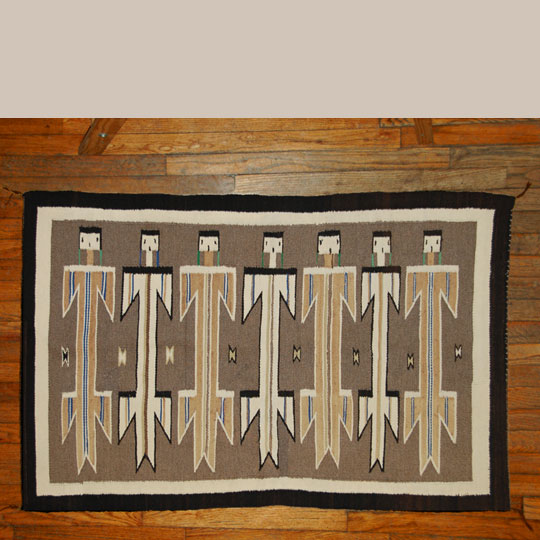 Yei are the Holy People of the Diné who are represented in sand paintings. They are both female and male and they are pictured with masks. Female Yei are represented with square or rectangular frontal masks and male are represented with a rounded mask that covers the whole head.
Yei are the Holy People of the Diné who are represented in sand paintings. They are both female and male and they are pictured with masks. Female Yei are represented with square or rectangular frontal masks and male are represented with a rounded mask that covers the whole head.
There has always been a strict rule that sand paintings be destroyed before sunset and never produced in permanent form. It is not surprising, then, that there was an uproar among the Diné when the first rugs were made depicting Yei Holy People. It is believed that the first ones were woven around 1880 although they were not generally seen until after 1900. By 1920, they were being woven throughout the Navajo Reservation.
Painting of Two Tewa Clowns during Ceremonial Function by Ka-Tside Tahn - C3714
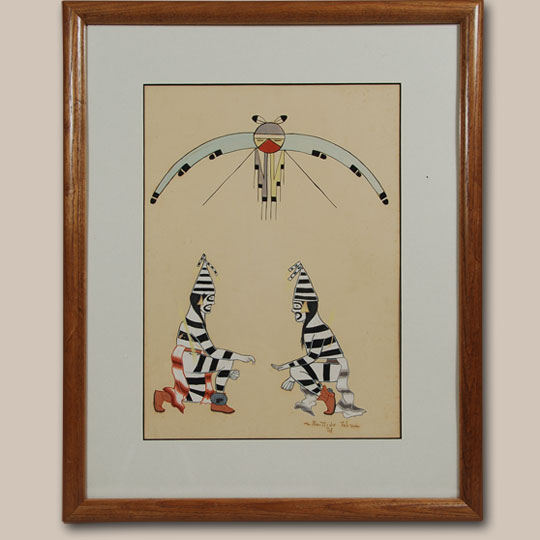 This San Juan Pueblo artist Ka-Tside Tahn is listed in The Biographical Directory of Native American Painters. However, there is no other information concerning him except his Tewaname and that he was exhibited at the American Indian Exposition and Congress in Tulsa, Oklahoma in 1932. There is no English name, no birth or death dates or any educational or profession information.
This San Juan Pueblo artist Ka-Tside Tahn is listed in The Biographical Directory of Native American Painters. However, there is no other information concerning him except his Tewaname and that he was exhibited at the American Indian Exposition and Congress in Tulsa, Oklahoma in 1932. There is no English name, no birth or death dates or any educational or profession information.
Hopi Pueblo Low and Wide Polychrome Jar by White Swann - C3712B
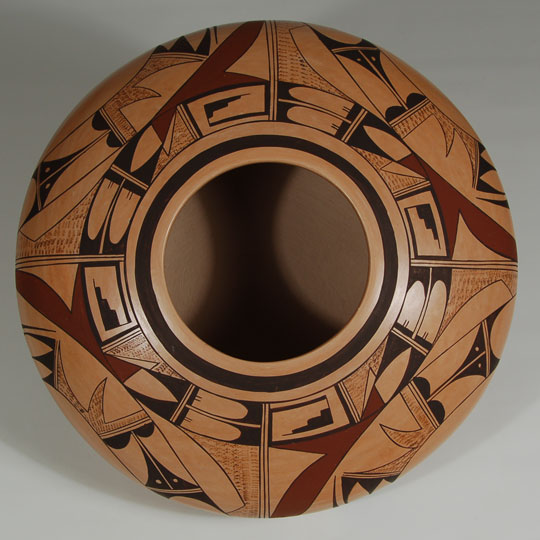 Dolly Joe Navasie is best known by her name White Swann. She is a daughter of Eunice Navasie (Fawn) and granddaughter of Poli-Ini who were her mentors. She learned to work with clay from age six and learned to paint pottery by age seventeen. She uses traditional coil method and all natural pigments, polishes her pottery with river stones and fires outdoors using sheep dung for fuel.
Dolly Joe Navasie is best known by her name White Swann. She is a daughter of Eunice Navasie (Fawn) and granddaughter of Poli-Ini who were her mentors. She learned to work with clay from age six and learned to paint pottery by age seventeen. She uses traditional coil method and all natural pigments, polishes her pottery with river stones and fires outdoors using sheep dung for fuel.
Yavapai Apache Polychrome Pictorial Basket - C3694
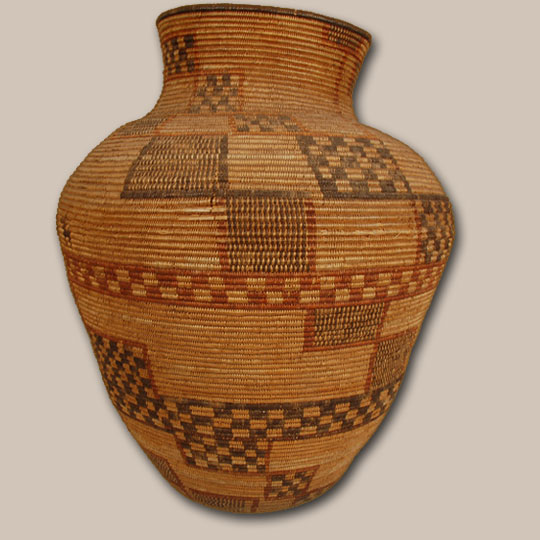 The members of the Yavapai-Apache Nation, a sovereign Native American tribe from the Verde Valley, Arizona, have two culturally distinct backgrounds and speak two indigenous languages. The Yavapai originate from Yuman-speaking peoples known as the Pai and the Apache descend from an Athapaskan background similar to other Apache groups to the East.
The members of the Yavapai-Apache Nation, a sovereign Native American tribe from the Verde Valley, Arizona, have two culturally distinct backgrounds and speak two indigenous languages. The Yavapai originate from Yuman-speaking peoples known as the Pai and the Apache descend from an Athapaskan background similar to other Apache groups to the East.
Originally, the Yavapai and Apache tribes were separate and distinct tribes who coexisted peacefully for several hundred years. They have existed as one tribal nation since 1934. The Yavapai-Apache Tribal reservation is located at Camp Verde, about 90 miles north of Phoenix and 50 miles south of Flagstaff, along Interstate 17.
Acoma Pueblo Polychrome Olla with Black-on-white Design - C3654B
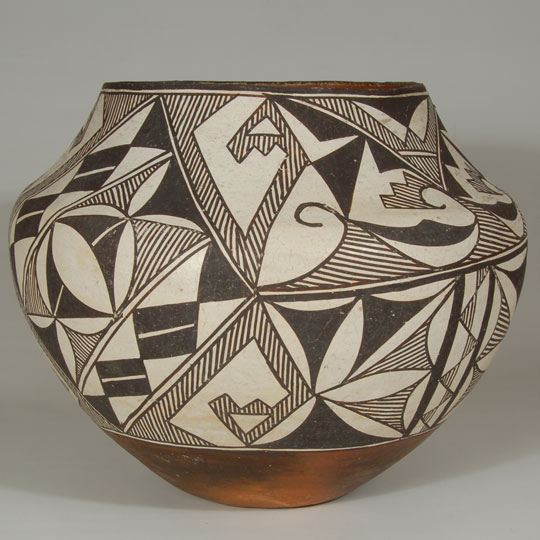 Acoma Pueblo clay, as well as that from most pueblos, requires a tempering agent to be mixed with the clay in preparation for forming pottery. Acoma potters gather broken pottery fragments from the grounds of the pueblo and grind them up to a powdery substance and that is then added to the clay as a temper agent. The result of doing this is a continuation of the life of a previous pot into the life of a new pot-resulting in an unbroken chain of continuity in the life of an Acoma pot.
Acoma Pueblo clay, as well as that from most pueblos, requires a tempering agent to be mixed with the clay in preparation for forming pottery. Acoma potters gather broken pottery fragments from the grounds of the pueblo and grind them up to a powdery substance and that is then added to the clay as a temper agent. The result of doing this is a continuation of the life of a previous pot into the life of a new pot-resulting in an unbroken chain of continuity in the life of an Acoma pot.
Laguna Pueblo Historic Polychrome Child’s Olla - C3642i
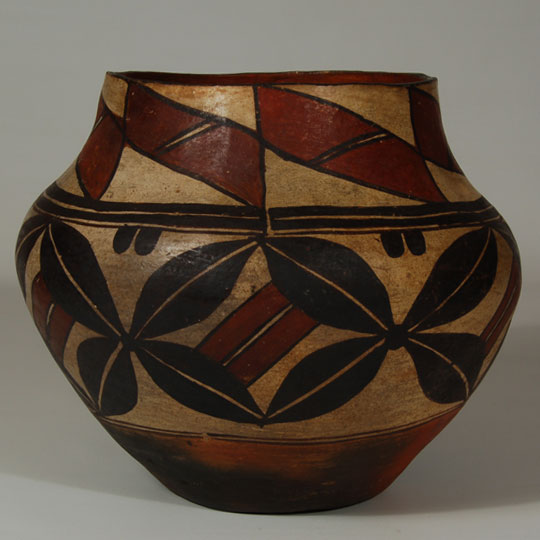 This is an historic child-size water jar that has been determined to have originated at Laguna Pueblo, probably in the early 1900s. It is an exceptional work of art. The design field is separated into body design and neck design, which perfectly accentuates and compliments the form of the jar. The neck design is comprised of stacked and tilted parallelograms, each painted in dark red, outlined in black, and split in the center with a white line. The parallelograms extend from the edge of the rim down to the framing line at the shoulder.
This is an historic child-size water jar that has been determined to have originated at Laguna Pueblo, probably in the early 1900s. It is an exceptional work of art. The design field is separated into body design and neck design, which perfectly accentuates and compliments the form of the jar. The neck design is comprised of stacked and tilted parallelograms, each painted in dark red, outlined in black, and split in the center with a white line. The parallelograms extend from the edge of the rim down to the framing line at the shoulder.
The body design is strong and bold black floral elements, each petal of which is split with a white line down its center. These floral elements encircle the body and each is connected with a deep red parallelogram like those on the neck design. Black droplets in pairs are suspended from the lower slim framing line, barely discernable because it is overpowered by the wide black framing line above it that also is split down its center with a white line.
Hopi Pueblo Sikyatki-style Polychrome Large Seed Jar - C3642J
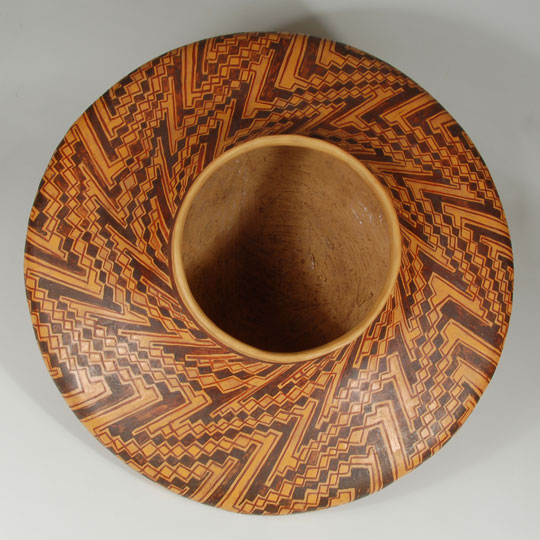 This very large Southwest Indian Pottery seed jar, from Hopi Pueblo, with an extreme flexure and an amazing design is not signed with the name of a potter. The shape is reminiscent of Sikyatki seed jars and is certainly a contemporary creation meant to respect the work of the Sikyatki potters. The design is comprised of triangles, rectangles, squares and lines executed in yellow, black and red pigments. The seed jar balances beautifully on a base the diameter of a U. S. quarter coin.
This very large Southwest Indian Pottery seed jar, from Hopi Pueblo, with an extreme flexure and an amazing design is not signed with the name of a potter. The shape is reminiscent of Sikyatki seed jars and is certainly a contemporary creation meant to respect the work of the Sikyatki potters. The design is comprised of triangles, rectangles, squares and lines executed in yellow, black and red pigments. The seed jar balances beautifully on a base the diameter of a U. S. quarter coin.
Nineteenth Century Polychrome Olla from Zuni Pueblo circa 1875 - C3651A
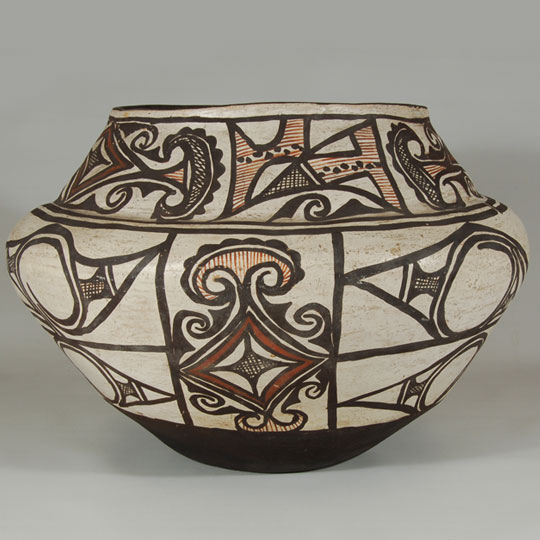 This Zuni Pueblo jar has the design layout described by Harlow and Lanmon as that used between 1870 and 1880. The design layout has two vertical panels on opposing sides of the vessel and two horizontal panels with capped spirals in mirror reflective designs, also on opposing sides of the vessel. Lastly, the neck design contains elements from the body design. There is a slight puki depression on the underside. The capped spiral designs are the major design elements on the body, without heartline deer, medallions or small birds.
This Zuni Pueblo jar has the design layout described by Harlow and Lanmon as that used between 1870 and 1880. The design layout has two vertical panels on opposing sides of the vessel and two horizontal panels with capped spirals in mirror reflective designs, also on opposing sides of the vessel. Lastly, the neck design contains elements from the body design. There is a slight puki depression on the underside. The capped spiral designs are the major design elements on the body, without heartline deer, medallions or small birds.
Santa Clara Pueblo Globular Red Melon Jar by Virginia Garcia - C3656
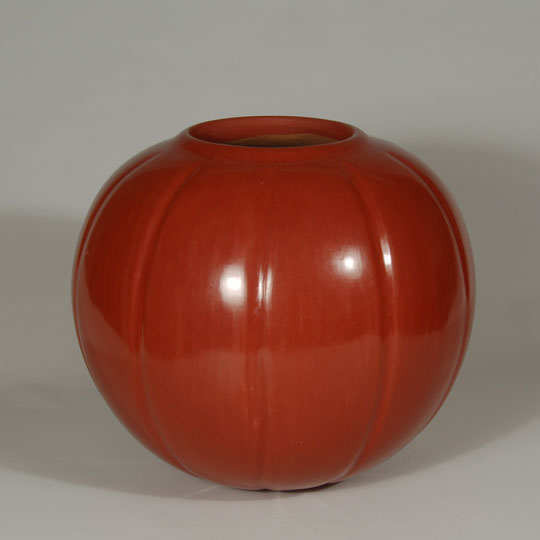 Virginia Garcia descends from a lineage of Santa Clara and Ohkay Owingeh potters. She is the youngest sister of Greg and Tina Garcia, the niece of Angela Baca, and the granddaughter of Severa Tafoya. Like others in her family, she is an accomplished artist, as this elegant redware jar suggests.
Virginia Garcia descends from a lineage of Santa Clara and Ohkay Owingeh potters. She is the youngest sister of Greg and Tina Garcia, the niece of Angela Baca, and the granddaughter of Severa Tafoya. Like others in her family, she is an accomplished artist, as this elegant redware jar suggests.

